From the Resene decorating blog
Japan has influenced interior design in western countries ever since the late 19th Century when Europe, particularly France, became enamoured with Japanese culture, colours and prints.
These days Japanese culture and design still has a strong influence all over the world, whether it’s the ornate motifs and colours seen in kimono silks, or the more pared back, zen-like style built on natural fibres, wood finishes and a neutral palette of warm greens and browns.
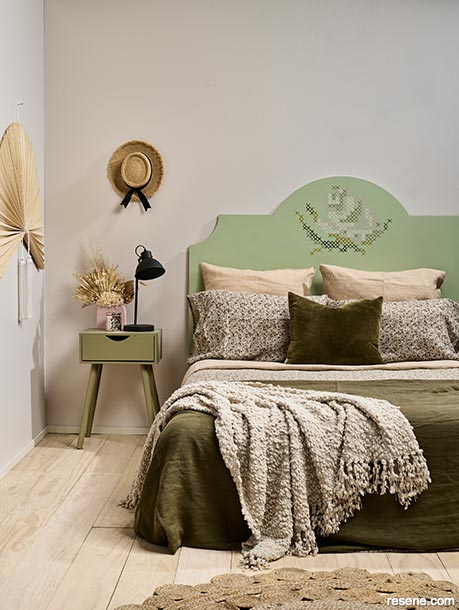
Soft natural colours, handcrafted features and an emphasis on natural fibres mean this bedroom is nicely balanced between Scandi and Japanese influences.
Walls painted in Resene Eighth Joss, headboard in Resene Norway with a painted cross-stitch effect feature in Resene Quarter Joss, Resene Woodrush, Resene Planter, Resene Half Malta, Resene Bandicoot, and Resene Lemon Ginger, bedside table in Resene Bandicoot and lamp in Resene Karaka. Bedlinen, cushions and throw from Citta, fan from The Cane Collective, hat from Country Road. Project by Annick Larkin, image by Bryce Carleton.
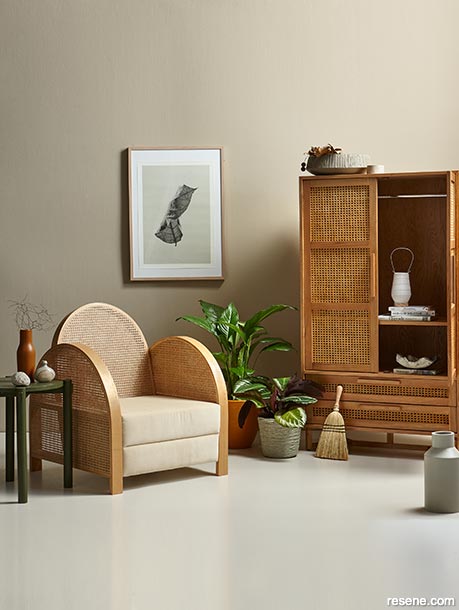
This natural colour palette keeps to warm shades for a finished sitting area that is orderly, calming and inviting.
Walls painted in Resene Double Sisal, floor in Resene Parchment, side table in Resene Scrub, vase on the tabletop in Resene Korma, large plant pot in Resene Mai Tai, basket planter in Resene Double Lemon Grass and tall floor vase in Resene Triple Ash. Robe from Freedom, chair from Douglas and Bec, paper lantern from Everyday Needs, artwork from Paper Plane in A1 size frame from Factory Frames. Project by Gem Adams, image by Wendy Fenwick.
In modern times, this second, simple design aesthetic has evolved and merged with the similarly minimalistic feel of Scandi design, to create the fusion trend of Japandi.
Simply put, Japandi is exactly that – a mix between Japan style and Scandi, with a focus on simplicity, using natural colours and organic shapes, with textural elements. Both focus on well-made quality features, functionality and sustainability, over throw-away culture and are all about reconnecting with natural processes, and the natural environment.
Japandi tends to be more sleek and sophisticated, and less rustic than classic Scandi style, but with a warmer, richer colour palette. It also embraces the Japanese idea of beauty in imperfection and change, known as wabi-sabi.
With all these things in mind, it’s not hard to see why we’ve become fans of adopting Japandi style in our homes as we all try to live more sustainably and more connected with the natural environment.
Wabi-sabi is a strong part of Japanese culture; part philosophy, part artistic concept and part personal value. It is in its simplest form about appreciating the beauty of transience and imperfect things.
When it comes to influencing interiors, wabi-sabi is about a more loose, relaxed approach with asymmetric layouts, aged surfaces, raw and natural materials and handmade products. It’s about letting things be, rather than trying to force them into being something different.
Japandi interiors often feature hand-made items, or artisanal finishes that have texture and rough edges or are slightly wonky in shape rather than being hard, shiny and rigid. In practical terms it might mean a pile of mis-matched cushions in natural fibres, instead of a perfectly matching, curated collection.
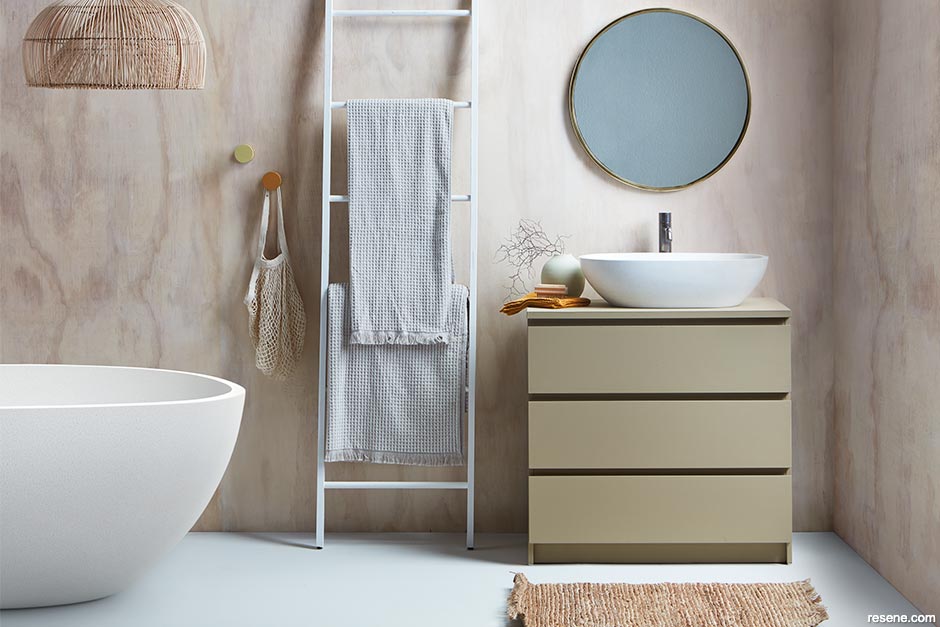
The Japandi colour palette is undeniably neutral and natural, but that does not mean everything fades to beige.
While a Scandi colour scheme is fresh neutrals, Japandi goes richer and more colour saturated.
Try browns that are more taupe than grey like Resene Mission Brown or Resene Beaten Track. Try them with dusky blues like Resene Lazy River and ochre Resene Gold Coast or Resene Rusty Nail.
Greens are muted and sage-toned such as Resene Paddock or Resene Flax while neutral backgrounds are oaty and warm like Resene Blanc or Resene Double Merino.
As with Scandi style, wood finishes that showcase the grain and story of the wood are a big part of a Japandi aesthetic. Consider richer, darker wood stain finishes like Resene Colorwood Mahogany or Resene Colorwood Dark Oak. You could also incorporate notes of green in Resene Colorwood Crowshead or try a washed finish with Resene Colorwood Shade from the We Speak Beach collection for that imperfect, weathered finish.
Another way to get that weathered or textural finish is with Resene FX Paint Effects Medium or Resene Sandtex Mediterranean effect.
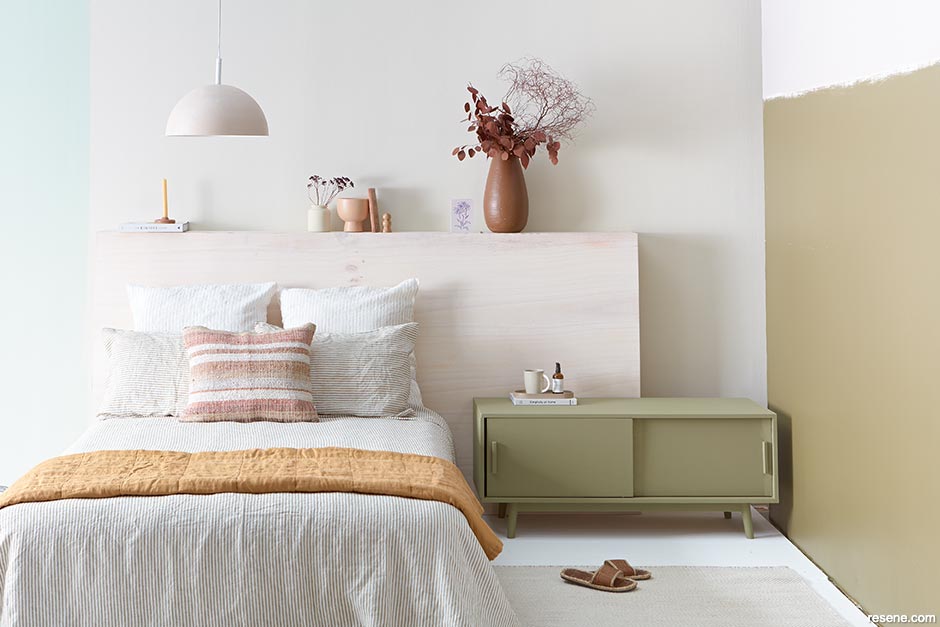
Decluttering your room is a good place to start – with any interior makeover, but particularly with a Japandi look. While not as strictly decluttered as a Scandi or minimalist look, Japandi does focus on the function of items in your space.
That doesn’t mean there’s no room for decor or art; sometimes a piece’s function is that it brings you joy to look at it! But take it as an opportunity to assess the items you have, the function they perform and whether you need or want them in the space. For a true Japandi space, you’re looking for clarity and openness with warmth and naturalism.
Dining rooms or bathrooms can be a good place to start with Japandi as they are both intrinsically functional spaces where a lack of clutter with some comfort go hand-in-hand.
Once you have chosen your rich, neutral colour scheme look for ways to add in layers of natural texture. It might be in sisal mats, wool or woven throws, wood tables or shelves, potted plants or dried arrangements and cane-finished furniture.
Wallpapers with imperfect, fibre-like patterns in warm neutral colours like Resene Wallpaper Collection 410730 or Resene Wallpaper Collection FOL111 add immediate texture or soft edges to your space and can resemble Japanese rice-paper screens.
A design has to serve you and your lifestyle; you shouldn’t be adjusting your lifestyle to try and fit in with a design style! It can be easy to get caught up in the ‘rules’ of Japandi design and forget to create a room that you love and respond to.
Use the features of Japandi style to guide you in your makeover. If you want to add in more colour do it. Dusky pinks that resemble cherry blossoms like Resene Vintage or scorched reds like Resene Dawnbreaker will work really well with the muted neutrals, greens and browns of a Japandi palette. So too, will notes of weathered brass or gold.
Adding a beachy spin on the look with stormy sea blues like Resene Undercurrent or Resene Tarawera will also work well, as will charcoal finishes instead of true blacks. Try Resene Foundry, Resene Element or Resene Colorwood Dark Ebony.
Top tip: Add bolder Japanese motifs with a wallpaper print like the pastel cherry blossom of Resene Wallpaper Collection 542141.
The overall idea of Japandi is to create a space that is calm, uncluttered and warm, yet refreshing, a space that you’ll love to come home to.

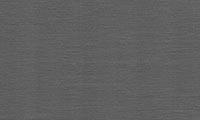
August 29, 2022
Visit your local Resene ColorShop for expert advice and all the products and accessories you need to make the most of your home.
Book a colour consult | Ask a Colour Expert | Ask a Paint Expert
Resene's decorating blog
Paint your home beautiful! Discover the latest decorating trends, tips and colour news.
![]()
Previous «
The power of pattern
![]()
Blog home
View the latest trends, tips and news
![]()
» Next
Wine reds for every room and every style